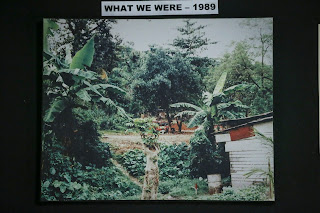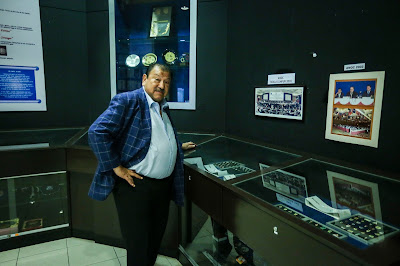Memories of Ampang Park by Tony Mariadass
“Ampang Park shopping complex, holds fond memories for
me for as a schoolboy, it was my playground.
I had the pleasure of seeing the complex – the first
shopping complex in Malaysia – being built and officially opening its doors in
1973.
I was in Form Three then and the very next year, I
moved to about fifteen minutes’ walk from the complex, where my late father was
the steward for a guest house in Jalan Freeman (now Jalan Ampang Hilir).
While there was a bus which went to Ampang Hilir once
every hour, the last bus was at 7pm and if for any reason I missed that bus, I
had to get down in front of Ampang Park and walk along Circular Road (later
Jalan Pekeliling and now Tun Razak) to reach home.
And sometimes after school in St John Institution, my
friend and football teammate Anuar Che Wan, who also stayed at Ampang Hilir,
would rush after school at 1.20pm to catch the 1.30pm bus and many a time
missed it.
So we took the bus to Ampang Park and walked home. It
happened more often than not and we would end up at the Complex to get some
cool air and do some window shopping besides looking at the ‘scenes’ or what we
used to call ‘cuci mata’, before heading home.
We were students and did not have money to spend at
the complex. Occasionally we would have saved money to get an ice-cream at the ice-cream
parlour on the ground floor.
The Fitzpatrick’s supermarket on the ground floor was
another favourite place of ours we would look at the grocery displayed and
occasionally bought a bun or sweet before we headed home.
On weekends, Ampang Complex would be our playground in
the mornings and evenings, we would be playing football in our neighbourhood.
During the weekends, we would cycle to the complex and
would chain our bicycles at the back and many a time had problems with the
security guards who refused to allow us to leave our bicycles at bays meant for
motorcycles.
Once in a while we would watch a movie at the complex.
Traffic then was a breeze then and it was just two
single roads in front of Ampang Park. Only on weekends, the traffic got heavier
as almost the whole town converged to the complex which was a hit then.
I and my friend Anuar and with a few more friends from
the neighbourhood had spent many hours combing the four-storey building.
Another favourite spot of ours was the playground on
the rooftop where the dodgem bumper cars was our favourite. Again it was only
in rare occasions we had enough money to ride on it. But we spent hours just
watching the ‘rich kids’ having fun for hours.
Having been hooked to Ampang Park and wanting to come
to the complex as a ‘real patron’ I decided to organise a farewell do for my
classmates of 1975 after our final Malaysian Certificate of Education (MCE)
paper in November.
We managed to get about ten of us interested and each
had to fork out about RM20 (which was big money then) for a night out at the
rooftop Beer Garden.
It was our first taste of beer for most of us and we
arrived early to enjoy the ‘Happy Hour ‘prices.
It was a night to remember as we stayed late, listened
to the resident band and stayed over at a friend’s father shop house along
Jalan Silang.
Till today, we talk about it and will definitely be
the main topic as about 20 classmates of mine meet next Friday for 40 year
reunion with some of our teachers too.
After leaving school and doing my form six in St
John’s, but through night classes under the Further Education Classes (FEC), I had
to look for a job to pay for my school fees.
As it happened I found a job as a despatch clerk with
the Austrian Trade Commission which was located on Persiaran Hampshire, which
was five minutes away from Ampang Park.
I worked there for a year and spend more time in
Ampang Park, this time with a salary, I could buy clothings, shop at the
supermarket and visit the many outlets.
Come Christmas, I bought all my gifts from the
complex.
Ampang Park had a
wide range offers in Malay fashion, every day shopping needs like textiles,
shoes and handbags, groceries, toiletries and household products, as well as
banking, post office, travel, and currency exchange services. It had
photographic stores with the latest cameras and accessories, beauty and hair
salons offering a range of attractive styles and spa services to suit every
budget.
It was also a
food-haven with renowned food and beverage outlets, serving delicious local and
international cuisine. It was a one-stop outlet.
How can I forget the
MacDonalds where I spent many hours.
But sadly after
moving out of the area, I had hardly revisited it, especially with so many
complexes springing up.
But each time I pass
Ampang Park, memories will come flooding back, especially how I grew up there
as a schoolboy and teenager.
With news that the
iconic Ampang Park mall will be demolished for the planned underground Mass
Rapid Transit (MRT) station, is indeed sad.
Memories will be erased
or will only be remembered as memories without the building standing there to
remind the good times for those who grew up with it.
Can it be saved for
nostalgic reasons? Unlikely as more often than not in the name of development
many historical and iconic sites have had to make way.
Whatever happens,
Ampang Park will be etched in my memory for as long as I live.”


























